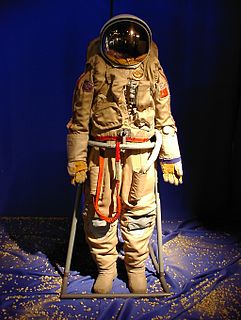 W
WAn environmental suit is a suit designed specifically for a particular environment, usually one otherwise hostile to humans. An environment suit is typically a one-piece garment, and many types also feature a helmet or other covering for the head. Where the surrounding environment is especially dangerous the suit is completely sealed.
 W
WThe 2suit is a garment designed to facilitate sex in weightless environments. It has been tested in microgravity during a parabolic flight.
 W
WAn atmospheric diving suit (ADS) is a small one-person articulated anthropomorphic submersible which resembles a suit of armour, with elaborate pressure joints to allow articulation while maintaining an internal pressure of one atmosphere. The ADS can be used for very deep dives of up to 2,300 feet (700 m) for many hours, and eliminates the majority of significant physiological dangers associated with deep diving; the occupant need not decompress, there is no need for special gas mixtures, nor is there danger of decompression sickness or nitrogen narcosis. Divers do not even need to be skilled swimmers, but the disadvantage is limited dexterity.
 W
WA cleanroom suit, clean room suit, or bunny suit, is an overall garment worn in a cleanroom, an environment with a controlled level of contamination. One common type is an all-in-one coverall worn by semiconductor and nanotechnology line production workers, technicians, and process / equipment engineers, as well as people in similar roles creating sterile products for the medical device industry.
 W
WThe Demilitarization Protective Ensemble (DPE) is a heat-sealed, one-time-use positive pressure personnel suit.
 W
WA diving suit is a garment or device designed to protect a diver from the underwater environment. A diving suit may also incorporate a breathing gas supply. but in most cases applies only to the environmental protective covering worn by the diver. The breathing gas supply is usually referred to separately. There is no generic term for the combination of suit and breathing apparatus alone. It is generally referred to as diving equipment or dive gear along with any other equipment necessary for the dive.
 W
WA dry suit or drysuit provides the wearer with environmental protection by way of thermal insulation and exclusion of water, and is worn by divers, boaters, water sports enthusiasts, and others who work or play in or near cold or contaminated water. A dry suit normally protects the whole body except the head, hands, and possibly the feet. In hazmat configurations, however, all of these are covered as well.
 W
WExtreme cold weather clothing refers to clothing for arctic or mountainous areas. Its primary function is to trap air as an insulator to prevent heat loss from the wearer's body. Secondary and necessary is to conduct water vapor away from the body to keep the insulating layers dry. A shell keeps the wind from disturbing the still air in the insulating layers. In warmer conditions, the shell protects from water intrusion.
 W
WA fire proximity suit is a suit designed to protect a firefighter or volcanologist from extremely high temperatures. They were first designed and used in the 1930s. Originally made of asbestos fabric, current models use vacuum-deposited aluminized materials.
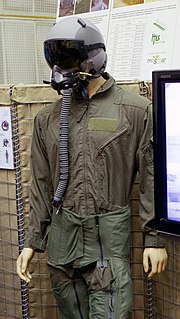 W
WA g-suit, or anti-g suit, is a flight suit worn by aviators and astronauts who are subject to high levels of acceleration force (g). It is designed to prevent a black-out and g-LOC caused by the blood pooling in the lower part of the body when under acceleration, thus depriving the brain of blood. Black-out and g-LOC have caused a number of fatal aircraft accidents.
 W
WA hazmat suit is a piece of personal protective equipment that consists of an impermeable whole-body garment worn as protection against hazardous materials. Such suits are often combined with self-contained breathing apparatus (SCBA) to ensure a supply of breathable air. Hazmat suits are used by firefighters, emergency medical technicians, paramedics, researchers, personnel responding to toxic spills, specialists cleaning up contaminated facilities, and workers in toxic environments.
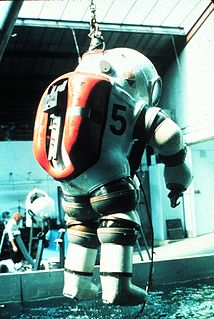 W
WThe JIM suit is an atmospheric diving suit (ADS), which is designed to maintain an interior pressure of one atmosphere despite exterior pressures, eliminating the majority of physiological dangers associated with deep diving. Because there is no need for special gas mixtures, nor is there danger of nitrogen narcosis or decompression sickness ; the occupant does not need to decompress when returning to the surface. It was invented in 1969 by Mike Humphrey and Mike Borrow, partners in the English firm Underwater Marine Equipment Ltd (UMEL), assisted by Joseph Salim Peress, whose Tritonia diving suit acted as their main inspiration. The suit was named after Jim Jarrett, Peress' chief diver.
 W
WThe Mercury space suit was a full-body, high-altitude pressure suit originally developed by the B.F. Goodrich Company and the U.S. Navy for pilots of high-altitude fighter aircraft. It is best known for its role as the spacesuit worn for all manned Project Mercury spaceflights.
 W
WMOPP is protective gear used by U.S. military personnel in a toxic environment, e.g., during a chemical, biological, radiological, or nuclear (CBRN) strike:Protective mask — Commonly referred to as a gas mask or pro mask. It is designed to filter harmful chemical and biological agents, as well as irradiated particles from the air to allow the wearer to breathe safely. No protective masks filter out gases such as carbon monoxide, and in situations requiring that level of protection, external breathing apparatus is employed. Mask carrier — Protects the mask from damage. It is usually worn as part of battle gear for easy access and usually contains a technical manual, extra filter, spare parts, chemical detection papers, and nerve agent antidote kits (NAAK). Over garments — Joint Service Lightweight Integrated Suit Technology (JSLIST) Specially designed clothing to be worn over the normal uniform. These garments are designed to allow maximum airflow for cooling while keeping chemical and biological agents from reaching the skin of the wearer. Some are equipped with a charcoal lining to neutralize some agents. Military personnel often equip over garments with strips of M9 Detector Paper to identify chemical agents on the battlefield they might come in contact with. M9 Detector paper is worn to detect chemical liquid agents that a service member may brush against while in MOPP gear. It is worn in three different areas of the suit. It is worn on the dominant arm, bicep area, on the wrist of the opposite arm, and on the dominant leg, shin area. It is also placed on lower levels of vehicles for detection purposes. Gloves and overboots — (JSLIST) Highly durable rubber, designed with combat operations in mind. Used to prevent contact with agents.
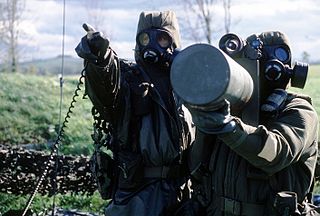 W
WAn NBC suit, also called a chemsuit or chem suit or chemical suit is a type of military personal protective equipment. NBC suits are designed to provide protection against direct contact with and contamination by radioactive, biological or chemical substances, and provide protection from contamination with radioactive materials and some types of radiation, depending on the design. They are generally designed to be worn for extended periods to allow the wearer to fight while under threat of or under actual nuclear, biological, or chemical attack. The civilian equivalent is the hazmat suit. The term NBC has been replaced by CBRN, with the addition of a new threat, radiological, meaning radiological weapon.
 W
WThe Newtsuit is an atmospheric diving suit designed and originally built by Phil Nuytten.
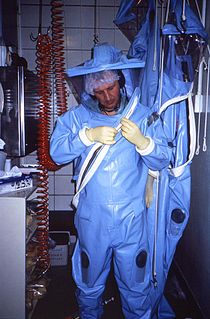 W
WPositive pressure personnel suits (PPPS) — or positive pressure protective suits, informally known as "space suits", "moon suits", "blue suits", etc. — are highly specialized, totally encapsulating, industrial protection garments worn only within special biocontainment or maximum containment (BSL-4) laboratory facilities. These facilities research dangerous pathogens which are highly infectious and may have no treatments or vaccines available. These facilities also feature other special equipment and procedures such as airlock entry, quick-drench disinfectant showers, special waste disposal systems, and shower exits.
 W
WA pressure suit is a protective suit worn by high-altitude pilots who may fly at altitudes where the air pressure is too low for an unprotected person to survive, even breathing pure oxygen at positive pressure. Such suits may be either full-pressure or partial-pressure. Partial-pressure suits work by providing mechanical counter-pressure to assist breathing at altitude.
 W
WA ski suit is a suit made to be worn over the rest of the clothes when skiing or snowboarding. A ski suit made for more casual winter wear outdoors may also be called a snowsuit [ˈsnoʊˌsut] and are often used by children as everyday outerwear in the winter season. Some suits are specifically made for snowboarders but most are used by either skiers or snowboarders regardless of the style.
 W
WA space suit or spacesuit is a garment worn to keep a human alive in the harsh environment of outer space, vacuum and temperature extremes. Space suits are often worn inside spacecraft as a safety precaution in case of loss of cabin pressure, and are necessary for extravehicular activity (EVA), work done outside spacecraft. Space suits have been worn for such work in Earth orbit, on the surface of the Moon, and en route back to Earth from the Moon. Modern space suits augment the basic pressure garment with a complex system of equipment and environmental systems designed to keep the wearer comfortable, and to minimize the effort required to bend the limbs, resisting a soft pressure garment's natural tendency to stiffen against the vacuum. A self-contained oxygen supply and environmental control system is frequently employed to allow complete freedom of movement, independent of the spacecraft.
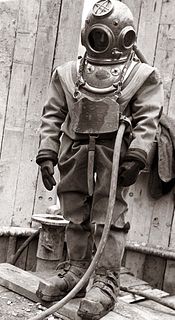 W
WStandard diving dress is a type of diving suit that was formerly used for all relatively deep underwater work that required more than breath-hold duration, which included marine salvage, civil engineering, pearl shell diving and other commercial diving work, and similar naval diving applications. Standard diving dress has largely been superseded by lighter and more comfortable equipment.
 W
WStrizh is a space suit that was originally developed for the crew of the Soviet/Russian Buran-class orbiters. It resembled the Sokol space suit worn by Soyuz crew members. It was designed to protect cosmonauts during a possible ejection from the spacecraft at altitudes of up to 30 km and speeds of up to Mach 3; the Buran-class orbiters were designed to incorporate ejection seats similar to those found on the Space Shuttle Enterprise and Columbia.
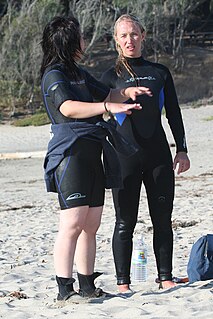 W
WA wetsuit is a garment worn to provide thermal protection while wet. It is usually made of foamed neoprene, and is worn by surfers, divers, windsurfers, canoeists, and others engaged in water sports and other activities in or on water, primarily providing thermal insulation, but also buoyancy and protection from abrasion, ultraviolet exposure and stings from marine organisms. The insulation properties of neoprene foam depend mainly on bubbles of gas enclosed within the material, which reduce its ability to conduct heat. The bubbles also give the wetsuit a low density, providing buoyancy in water.